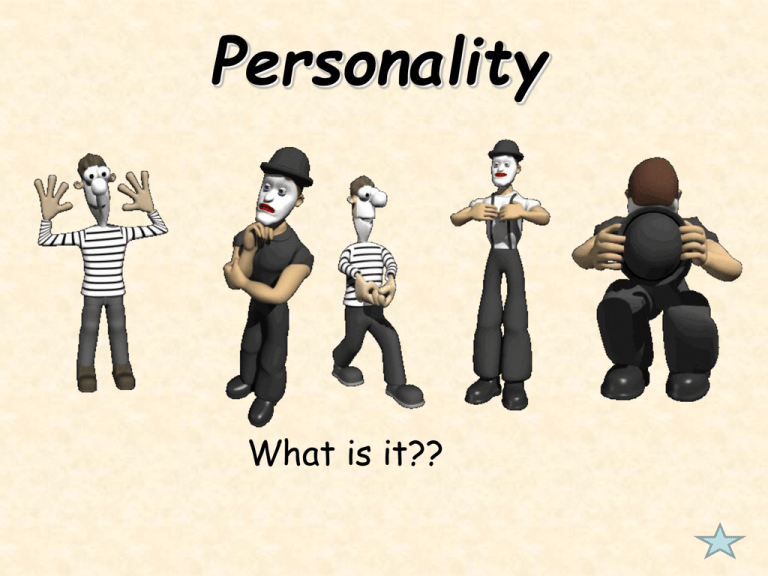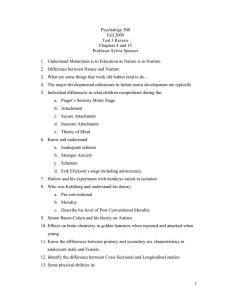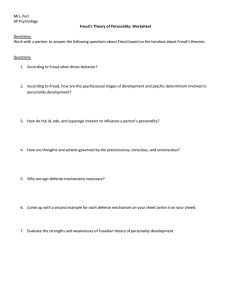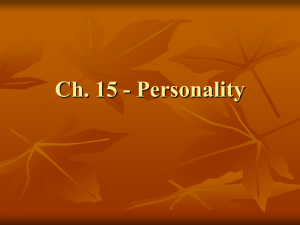Personality What is it??
advertisement

Personality What is it?? We use the term personality often but what does it actually mean? » “She has a wonderful personality” » “He has no personality” » “We seem to have a personality conflict” Personality • The collection of emotional, thought, and behavioral patterns unique to a person that is consistent over time • its who we are • how we act and react, how we interact and respond to the world We get a good idea of what personality is by listening to what we say when we use “I” – “I like…, I dislike…, I love…, I am good at…, I fear…, etc.” Psychodynamic Theory • Says personality is a product of tension and anxiety within us that drive our thoughts and behavior – unconscious thoughts and unresolved inner conflicts (usually centering on sex and aggression) – i.e. think Freud • Example – There is something going on inside of us, on some level, that produces the behavior and actions people see in us Trait Theory • Our personality resides inside our genes • Each person has certain characteristics (or traits) that we are born with which determine our behavior and personality – Example – a friendly person is likely to act friendly in a situation because of the traits in their DNA • Trait theorists usually believe these traits usually remain the same throughout our lives in spite of the environment we may be in – We cant change our DNA Social-Cognitive Theories • Says personality is learned either through conditioning or through social learning – think bobo doll (Bandura) and Skinner’s box • Environment and cognition are important factors in personality development • Reciprocal Determinism Humanistic Theories • States that personality is a product of free will and that people play an active role in determining how they behave • Individuals have a capacity for personal growth and have a goal of reaching ones full potential – Think self-actualization and Maslow Issues in Personality Theory The Following basic questions define the personality theorists’ image of human nature and personality Free will or Determinism? • Do we have control of ourselves? • Are we free to choose to be masters of our fate Or… • Are we victims of biological factors, unconscious forces, or external stimuli? Nature or Nurture? • Is our personality determined by the things we inherit Or… • shaped by the environment in which we live? Past, Present, or Future? • Is personality development complete in early childhood Or… • Is it independent of the past capable of being influenced by present or even future events, aspirations, and goals? Uniqueness or Universality? • Is the personality of each individual unique Or… • Are there broad personality patters that fit large number of people? Psychodynamic Perspective Of Personality Psychodynamic Theory It all started with Freud • Freud proposed psychology’s first and most famous theory of personality • Freud believed an individual’s personality emerged from an unresolved conflict between… – unconscious sexual impulses (most often starting in childhood) and societies rules and expectations • Freud believed that to resolve these conflicts he had to understand a persons mind ( or, psyche) • But what is the mind according to Freud?? The Mind According to Freud The Conscious Mind The thoughts and feelings we are aware of at any given time The Preconscious Mind Information that is stored and available at any time Memories like phone numbers The Unconscious Mind Mostly unacceptable thoughts, wishes, feelings, and memories If Freud could get people to open the door to this region they could start the healing process and understand their personality Freud's Early Exploration into the Unconscious • To get to a persons unconscious Freud used a process he called psychoanalysis (psyche (mind)=mind analysis) – A technique that tries to expose and interpret underlying unconscious motives and conflicts • Two specific psychoanalysis techniques that he used were – hypnosis and – free association (relax and say it all) Once Freud understood the mind and could reach the unconscious, he could begin to look at personality Freud's Personality Structure • He believed we all were born with pleasure-seeking biological impulses • However, we live in a society with rules that we internalize as we get older • Freud believed that the way we resolve this conflict (social rules vs. personal desires) would shape our personality. Freud thought there were 3 forces interacting to form and shape personality Id Superego Ego Id • Unconscious energy that drives us to satisfy basic survival, sexual and aggressive drives. – Present at birth – Is primitive and not affected by values, ethics, or morals • Id operates on the pleasure principle – the drive to achieve pleasure and avoid pain. – Demands immediate gratification Sometimes is illogical, irrational and can get us into trouble Superego • Part of personality that represents our internalized moral standards – Comparable to our conscience – learned from society • Focuses on what we should do, not what we’d like to do • Causes people to feel guilty when they go against society’s rules Ego • The boss of the conscious. • It is the great compromiser – Makes decisions after listening to both sides – Tries to satisfy the Id without offending the moral standards of the Superego • Called the “reality principle” Delays the demands and needs of the id until a more appropriate time Conflict and Anxiety • Freud believed that the id, the ego, and the superego are in constant conflict (always unconscious). • These conflicts can make a person feel anxious and to manage this feeling people use what Freud called… –defense mechanisms Defense Mechanisms The ego’s protective methods of reducing anxiety by distorting reality and preventing awareness of unacceptable sexual or aggressive impulses or wishes Seven major types Repression • The Mac Daddy defense mechanism. • Means to push or banish anxiety driven thoughts deep into unconscious. • Being sexually assaulted when you are five and not remembering this as an adult Regression • When faced with anxiety the person retreats to a more comfortable infantile stage. • Thumb sucking when you get scared at a movie. Reaction Formation • When a person behaves in a way that contradicts their actual thoughts • Being mean to someone you have a crush on. Projection • Disguise your own threatening impulses by attributing them to others. • Thinking that your spouse wants to cheat on you when it is you that really wants to cheat. Rationalization • Providing excuses or explanations to justify thoughts or behaviors • You don’t get into a college and say, “I really did not want to go there it was too far away!!” Displacement • Shifts the unacceptable impulses towards a safer outlet. • Instead of yelling at a teacher, you will take your anger out on him by spitting on his car Sublimation • Re-channel unacceptable impulses towards more acceptable or socially approved activities or areas • Channeling unacceptable aggressive feelings into aggressive sports play Freud's Stages of Psychosexual Development • Freud believed that your personality developed in your childhood – before 5 • Believed that children pass through a series of psychosexual stages. • Each stage has special conflicts and children’s ways of managing these conflicts influence their personalities Fixation Fixation – the inability to progress normally from one stage into another As an adult these fixations show up as a tendency to focus on the needs that were over-gratified or over-frustrated How do we assess the unconscious? We can use hypnosis or free association to get to the unconscious. But more often we use projective tests. Projective Tests • Provides a vague stimuli designed to trigger insight (projection) of one’s inner thoughts and feelings TAT Thematic Apperception Test • People express their inner feelings through stories they make about vague scenes TAT Rorschach Inkblot Test A set of ten inkblots designed to identify people’s inner thoughts when they are asked to interpret what they see in the inkblots. Rorschach Inkblot Test "This is a..." constitutes a "bad" response. You are supposed to know that the cards don't actually represent any recognizable figures, so saying something like "This looks like ..." is considered a more "healthy" response. "The only thing the inkblots do reveal is the secret world of the examiner who interprets them. These doctors are probably saying more about themselves than about the subjects." Advantages and Disadvantages of Projective Tests • Good - – they allow psychologists to assess unconscious aspects of personality • Good - – Open and vague – no way to know how responses will be interpreted – so you can not fake responses • However – questionable validity and reliability – hard to test Neo-Freudians • Psychologists that took some ideas from Freud and built upon them. Alfred Adler Karen Horney Carl Jung Alfred Adler • Believed the focus of personality research should be on social factors - not sexual ones. • Believed our behavior is driven by our efforts to conquer our feelings of inferiority – Inferiority Complex Carl Jung • Jung did focus on the unconscious, but just not an individual • Said we all have a collective unconscious – a shared/inherited well of memory from all people throughout history and cultures • Archetypes – thoughts or symbols that have the same meaning for all human beings – Example • shadow = the darker, evil side of human nature • or the idea or image of a hero figure Karen Horney • Thought Freud’s theory was to male dominated • Fought against Freud’s “penis envy” concept. • Thought men have “womb envy” – Thought social restraints, not anatomy, created psychological differences between males and females – Anxiety and helplessness is felt by people because of the hostile and competitive world not conflict with the id, ego, and superego





